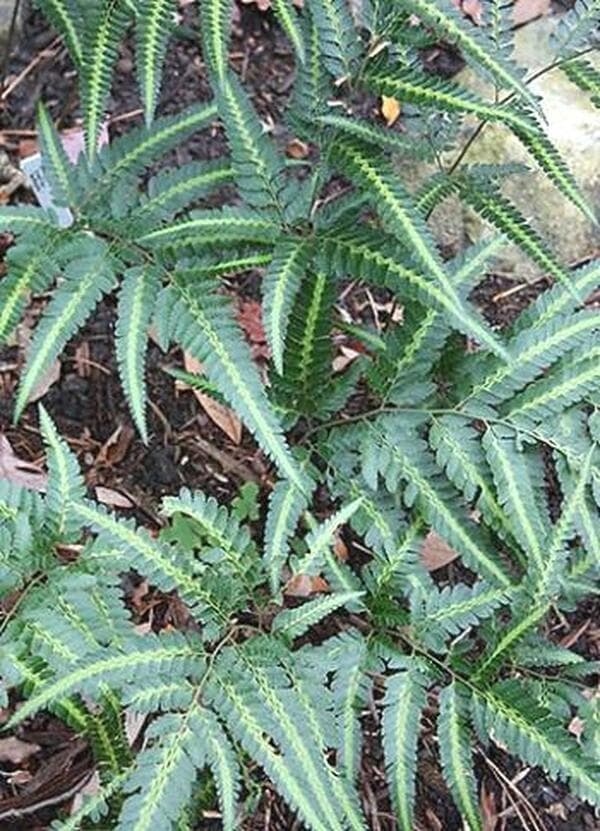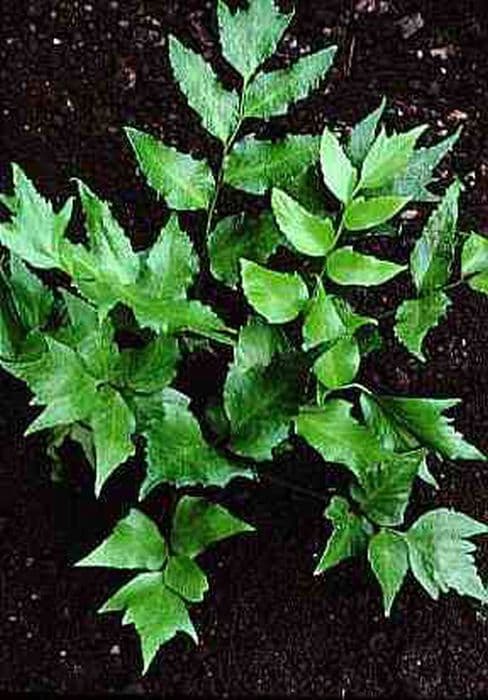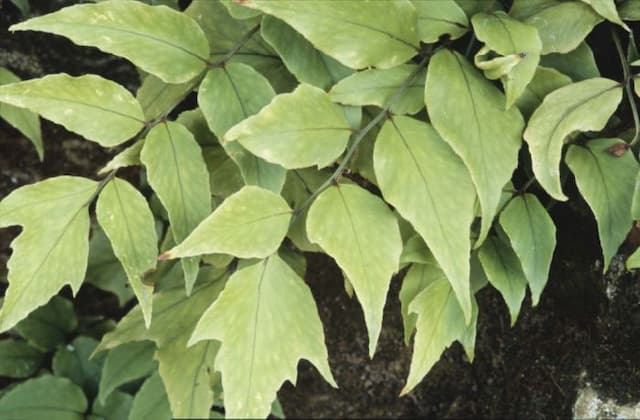Marginal wood fern Dryopteris marginalis

ABOUT
The marginal wood fern is a perennial, evergreen plant known for its lush and upright foliage. The leaves of this fern, commonly referred to as fronds, are long with a slightly arching form, creating a graceful appearance. These fronds are dark green with a leathery texture and a glossy sheen, contributing to the plant's robust visual appeal. Each leaf blade is divided into numerous leaflets, which are further subdivided into small, oblong segments, giving the fronds a delicate appearance reminiscent of intricate lacework. The leaflets are arranged in a feathery pattern along the axis of the frond, with the lower leaflets being slightly shorter than those near the middle, creating a tapered effect towards the base. The fronds typically emerge from a central rosette at the base of the plant. The spores, necessary for the plant's reproduction, are typically located on the underside of the leaflets, arranged in clusters known as sori. These sori are usually covered by discrete protective tissues at their early stages, which may be visible if the underside of the leaf is examined closely. As an evergreen fern, the marginal wood fern maintains its appealing green coloration throughout the year, adding consistent visual interest to the environments where it naturally occurs or is planted as ornamental foliage. The overall aesthetic of this plant is one of serene and classic fern beauty, with its richly verdant fronds contributing to a forested or woodland ambiance in gardens and natural settings alike.
About this plant
 Names
NamesFamily
Dryopteridaceae
Synonyms
Eastern Wood Fern, Marginal Fern, Marginal Woodfern, Marginal Shield Fern
Common names
Aspidium marginale, Dryopteris muenchii, Lastrea marginalis, Nephrodium marginale
 Toxicity
ToxicityTo humans
Dryopteris marginalis, commonly known as the marginal wood fern, is not considered toxic to humans. There are generally no symptoms of poisoning because it is not listed as a poisonous plant and therefore does not possess known toxic properties that would affect humans if ingested.
To pets
The marginal wood fern, is not known to be toxic to pets either. It does not contain any known compounds that are harmful if pets were to ingest it, and there should be no symptoms of poisoning from this plant. However, as with any non-food plant material, ingestion can potentially cause mild stomach upset in some animals due to the irritation of the digestive tract or the plant's fibrous nature.
 Characteristics
CharacteristicsLife cycle
Perennials
Foliage type
Evergreen
Color of leaves
Green
Height
1-2 feet (30-60 cm)
Spread
1-2 feet (30-60 cm)
Plant type
Fern
Hardiness zones
3-8
Native area
Eastern North America
Benefits
 General Benefits
General Benefits- Erosion Control: Dryopteris marginalis, also known as the marginal wood fern, can help stabilize soil and prevent erosion on slopes and in shady areas due to its rhizomatous growth.
- Habitat Support: Provides shelter and habitat for wildlife, particularly invertebrates such as insects which play a key role in the ecosystem.
- Aesthetic Appeal: Adds visual interest to shade gardens with its lush, green foliage, enhancing the overall design and feel of a landscape.
- Low Maintenance: Marginal wood fern is relatively low maintenance once established, requiring minimal care and being tolerant of a range of soil types.
- Drought Resistance: Once established, it is quite drought-tolerant, making it suitable for regions with occasional water shortages.
- Seasonal Interest: Offers year-round interest in many climates, with its evergreen fronds contributing to the winter garden landscape.
- Naturalization: Can naturalize in suitable climates, creating a self-sustaining population that contributes to the local flora diversity.
 Medical Properties
Medical Properties- Anthelmintic - Historically, Dryopteris marginalis, commonly known as the marginal wood fern, has been used for its properties to expel worms or parasitic nematodes from the gastrointestinal tract.
- Astringent - The plant has been used for its potential to contract tissues and reduce discharges, often applied to control diarrhea and internal bleeding.
- Fever reducer - There have been traditional uses of the plant to reduce fever, though this application is not supported by contemporary scientific evidence.
 Air-purifying Qualities
Air-purifying QualitiesThis plant is not specifically known for air purifying qualities.
 Other Uses
Other Uses- Dye Source: The leaves of the marginal wood fern can be used to create a light green dye for textiles.
- Garden Design: This fern is often used in shade gardens for its foliage texture, providing a contrast to other plants.
- Erosion Control: Marginal wood fern can help prevent soil erosion on slopes or banks due to its root system.
- Floral Arrangements: The fronds can be used in fresh or dried floral arrangements, giving a natural and woodsy aesthetic.
- Winter Interest: The evergreen fronds provide greenery and interest in winter gardens when other plants have died back.
- Habitat Restoration: It's used in woodland restoration projects to help reestablish natural plant communities.
- Education: The plant is utilized in educational programs to teach about native plant species and fern reproduction.
- Biomonitoring: Scientists may use marginal wood fern in biomonitoring studies to assess the health of forest ecosystems.
- Ground Cover: It serves as a low-maintenance ground cover for shaded areas.
- Crafts: The fronds can be incorporated into craft projects, such as making wreaths or other decorative items.
Interesting Facts
 Feng Shui
Feng ShuiThe Eastern Wood Fern is not used in Feng Shui practice.
 Zodiac Sign Compitability
Zodiac Sign CompitabilityThe Eastern Wood Fern is not used in astrology practice.
 Plant Symbolism
Plant Symbolism- Shelter - Dryopteris marginalis, commonly known as Marginal Wood Fern, often grows on forest edges and shaded areas, symbolizing protection and shelter.
- Endurance - The Marginal Wood Fern's capacity to thrive in harsh conditions and less fertile soils is emblematic of resilience and endurance.
- Privacy - With its dense fronds, the Marginal Wood Fern can symbolize the need for privacy or seclusion, as it creates natural barriers in the wild.
- Discretion - The fern's subtle presence, often blending into the background, serves as a symbol for modesty and discretion.
- Antiquity - Ferns are ancient plants with a long fossil record, and the Marginal Wood Fern symbolizes a connection to the ancient and the primordial.
 Water
WaterTo water the Eastern wood fern effectively, ensure the soil is consistently moist but never waterlogged. Water the plant thoroughly once a week with approximately one to two gallons, depending on the size of the plant and the environmental conditions. Always check the top inch of the soil before watering; if it feels dry, it's time to water. During hotter months, the fern may require more frequent watering, while in the winter, less water is needed. Avoid overhead watering to minimize the risk of foliar diseases, and instead water directly at the base of the plant.
 Light
LightEastern wood fern thrives in partial to full shade conditions. The best location for this fern is a spot that simulates its natural woodland habitat, with dappled sunlight filtering through overhead foliage. Avoid direct sunlight, as this can scorch the fronds and cause stress to the plant. An ideal setting would be under the canopy of tall trees or on the north side of a building where it will receive indirect light.
 Temperature
TemperatureEastern wood ferns prefer cool to moderate temperatures, with ideal conditions ranging between 60 to 70 degrees Fahrenheit. They can tolerate a minimum temperature of 50 degrees Fahrenheit and can survive short periods of colder weather down to about 20 to 30 degrees Fahrenheit. It is important not to expose them to temperatures above 80 degrees Fahrenheit for prolonged periods, as this can cause heat stress.
 Pruning
PruningPruning Eastern wood ferns is mainly for aesthetic purposes, to remove old or damaged fronds and encourage fresh growth. It is best done in early spring before new growth begins. Cut back any dead or unsightly fronds to the base to maintain a tidy appearance and provide room for new fronds to emerge. Pruning is typically done only once a year, as the plant prepares for its growing season.
 Cleaning
CleaningAs needed
 Soil
SoilThe Eastern Wood Fern, Dryopteris marginalis, thrives best in a well-draining soil mix rich in organic matter with a pH range of 5.5 to 7.0. A mix of one part garden soil, one part peat moss or well-rotted leaf mold, and one part perlite or coarse sand is conducive for healthy growth.
 Repotting
RepottingEastern Wood Fern should be repotted every 2 to 3 years to replenish its soil and accommodate root growth. It's best to repot the plant in the spring.
 Humidity & Misting
Humidity & MistingEastern Wood Fern prefers high humidity levels, ideally around 60-70%, to mimic its natural forest floor habitat. Adequate humidity is vital for lush growth.
 Suitable locations
Suitable locationsIndoor
Place Eastern Wood Fern in shade, keep the soil moist, ensure high humidity.
Outdoor
Plant in shady area with moist, rich soil, and provide mulch.
Hardiness zone
3-8 USDA.
 Life cycle
Life cycleDryopteris marginalis, commonly known as marginal wood fern, begins its life cycle as a spore, which is produced in sporangia located on the underside of the fronds. When conditions are suitable, these spores germinate to form a gametophyte—a small, heart-shaped structure that carries out sexual reproduction. The gametophyte produces both sperm and eggs, which, upon fertilization, develop into a new sporophyte plant, completing the life cycle. This new sporophyte initially grows as a fiddlehead, or crozier, which uncurls and expands into a mature fern with fronds that can photosynthesize and eventually produce their own spores. The fronds of the marginal wood fern are evergreen and can carry out photosynthesis year-round in appropriate climates, contributing to the growth and health of the plant. As the fern matures, it may spread through its rhizomes, forming clonal colonies and thus ensuring its persistence in the habitat.
 Propogation
PropogationPropogation time
Spring to summer
The most popular way to propagate the marginal wood fern (Dryopteris marginalis) is by spore sowing. As a fern, it reproduces by spores rather than seeds. The best time for collecting spores is late summer when they reach a ripe stage and are typically dry and brown. You can dust the spores onto the surface of a moist, sterile potting mix, ensuring the potting environment has high humidity and is shielded from direct sunlight. It can take a few weeks to several months for spores to germinate and develop into a prothallus, from which the fern will eventually grow. Consistent monitoring to maintain appropriate moisture levels is crucial for successful spore germination.









